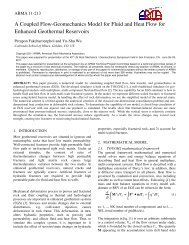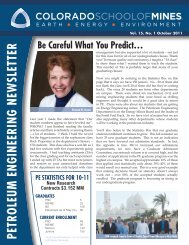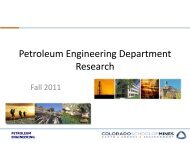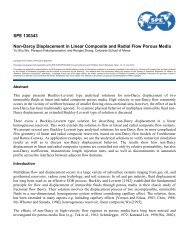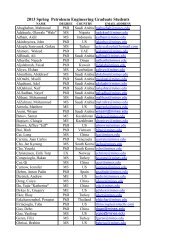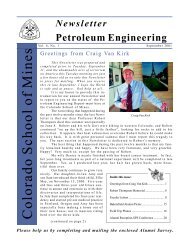SPE 146840 Pilot Testing Issues of Chemical EOR in Large ...
SPE 146840 Pilot Testing Issues of Chemical EOR in Large ...
SPE 146840 Pilot Testing Issues of Chemical EOR in Large ...
Create successful ePaper yourself
Turn your PDF publications into a flip-book with our unique Google optimized e-Paper software.
<strong>SPE</strong> <strong>146840</strong> 5Eq. 7 is called pseudo transfer function. Us<strong>in</strong>g this form we will have:o (8)wIn Eqs. 5, 6, and 7 the terms <strong>in</strong>side the bracket represent the driv<strong>in</strong>g forces. We have used both forms <strong>of</strong> transfer function <strong>in</strong>dual-porosity formulation. They provide very close results because as po<strong>in</strong>ted before <strong>in</strong> current dual-porosity formulationpressure gradient is negligible. The effects <strong>of</strong> capillary and gravity forces are different from case to case. They can worktogether or can be aga<strong>in</strong>st each other. For example <strong>in</strong> gas <strong>in</strong>jection always gravity difference will play the major role but <strong>in</strong>water flood<strong>in</strong>g both mechanisms might be effective. Add<strong>in</strong>g water and oil material balance equations give global pressureequation, and from that equation implicitly we can obta<strong>in</strong> fracture and matrix pressures. Overall pressure equation is providedby Eq.9:^ P<strong>of</strong>.k f , eff tf P<strong>of</strong> wwf o<strong>of</strong> D wf P cw<strong>of</strong> t qtf fctft(9)Solv<strong>in</strong>g water or oil material balance gives saturation explicitly per time step. To obta<strong>in</strong> saturations <strong>in</strong> matrix either Eq.2 orEq.4 is used. Auxillary equations for this part are given <strong>in</strong> Appendix A.Fracture surfactant material balanceSurfactant concentration per time step can be solved explicitly or implicitly us<strong>in</strong>g Eq. 9. In this equation pressures andsaturations are known at n+1 level. This equation <strong>in</strong>cludes diffusivity term, surfactant participation <strong>in</strong> oil phase, andsurfactant adsorption on the solid phase surface.kf , effwf kf , eff<strong>of</strong>. Cwsf Pwf wD Cwsf P<strong>of</strong> oD wCwsf / moCosf / m BwfB<strong>of</strong> D D ^^ SwfS (10)<strong>of</strong>. S .~ w C wsm S ~ o C osm Cwsf qwf Cosf q<strong>of</strong> f Cwsf Cosf t BwfB 1 f . r.asf <strong>of</strong>m m Eq. 11 accounts for surfactant participitation <strong>in</strong>to oil phase. To account for adsorption we used Longmuir isotherm adsorptionformula. This formulation is provided <strong>in</strong> Appendix B.Cos sCws (11)fMatrix surfactant material balanceSurfactant can penetrate <strong>in</strong>to matrix through transfer function terms; Eq. 12 accounts for this process. Upstream weight<strong>in</strong>gdeterm<strong>in</strong>e whether surfactant goes <strong>in</strong>to or out <strong>of</strong> matrix. In ideal condition surfactant from fracture goes with water transferfunction term. Adsorption is <strong>in</strong>cluded <strong>in</strong> the second part <strong>of</strong> the left right hand side <strong>of</strong> Eq.12. SwmS omwCwsf / m oCosf / m m Cwsm Cosm 1 m . r.asmt BwmBom (12)A conceptual model with the size <strong>of</strong> 10x1x10 grid blocks, with almost the same size <strong>of</strong> the conceptual model <strong>in</strong> CMG, hasbeen built us<strong>in</strong>g three different methods; dual-porosity, dual-permeability, and variable permeability/porosity f<strong>in</strong>e-gridmodel. Implicit-pressure/explicit-saturation (IMPES) formulation is implemented. S<strong>in</strong>gle-well dual-completion method isused <strong>in</strong> this conceptual model with <strong>in</strong>jection rate <strong>of</strong> 30 bbls/day. Surfactant <strong>in</strong>cremental oil recovery was <strong>in</strong>vestigated byus<strong>in</strong>g IFT reduction and wettability alteration methods. Dur<strong>in</strong>g surfactant <strong>in</strong>jection simulator calculates IFT, Capillarynumber or Bond number, residual oil saturation, relative permeability, capillary pressure, fluid heights <strong>in</strong> fracture and matrixnodes. IFT will be calculated based on surfactant concentration. We used two forms <strong>of</strong> Bond number and Capillary number:mkm w oNB . IFT.cosWhere,mw ogravity gradient <strong>in</strong> [psi/ft], m, porosity <strong>of</strong> the matrix,IFT, water-oil <strong>in</strong>terfacial tension <strong>in</strong> [dynes/cm], and cos is contact angle. In addition to use the above formulation, we haveused a comb<strong>in</strong>ation form <strong>of</strong> Capillary number and Bond number <strong>in</strong> the matrix, which gives close results as Bond number.Us<strong>in</strong>g the driv<strong>in</strong>g force <strong>in</strong> pseudo transfer function, we have:Nck is the absolute permeability <strong>of</strong> the matrix [md], 2.262 108 wf wmkmP cw<strong>of</strong>Pcwom w o h hm z. IFT . cos Where, z is matrix block height (ft) <strong>in</strong> z direction. To achieve a Bond number or Capillary number greater than 10-5 , weneed to have a very low IFT, which requires large amount <strong>of</strong> surfactant concentration <strong>in</strong>side the matrix. Our simulationshows that we need to <strong>in</strong>ject a high concentration <strong>in</strong>to the reservoir. Residual oil saturation will be <strong>in</strong>terpolated based on(13)(14)



